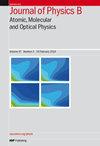利用 "设计者 "相干性控制双(肼)自由基阳离子模型中的电子转移:我们还能区分直接交换机制和超交换机制吗?
IF 1.5
4区 物理与天体物理
Q3 OPTICS
Journal of Physics B: Atomic, Molecular and Optical Physics
Pub Date : 2024-03-14
DOI:10.1088/1361-6455/ad2e31
引用次数: 0
摘要
我们模拟了双肼自由基阳离子模型中电子转移的两种机制:直接交换和超交换。计算受原子化学方法的启发,重点关注四个阳离子状态的相干叠加所产生的电子动力学。电子动力学源于艾伦费斯特方法中与时间相关的薛定谔方程的求解,与原子核的弛豫耦合。根据苯桥电子动力学与肼发色团动力学的耦合强度,可以观察到直接(约 15 fs 动力学)和超交换(约 2 fs 动力学)机制,并发现它们处于一个连续统一体中。这与化学途径方法形成了鲜明对比,在化学途径方法中,直接机制是通过锥形交点实现完全非绝热的,而超交换机制则涉及到一个中间自由基,其非配对电子定位在苯环上。因此,通过受化学启发的电子动力学方法,我们可以根据两种电子动力学耦合的强度来区分直接机制和超交换机制:慢速肼动力学(约 15 fs)和快速苯连接体动力学(约 2 fs)。在这个双(肼)自由基阳离子模型中,只有当中间耦合剂处于反醌态时,才能看到桥和肼发色团动力学的耦合。本文章由计算机程序翻译,如有差异,请以英文原文为准。
Using ‘designer’ coherences to control electron transfer in a model bis(hydrazine) radical cation: can we still distinguish between direct and superexchange mechanisms?
We have simulated two mechanisms, direct and superexchange, for the electron transfer in a model Bis(hydrazine) Radical Cation , which consists of two hydrazine moieties coupled by a benzene ring. The computations, that are inspired by the attochemistry approach, focus on the electron dynamics arising from a coherent superposition of four cationic states. The electron dynamics, originating from a solution of the time dependent Schrödinger equation within the Ehrenfest method, is coupled to the relaxation of the nuclei. Both direct (ca . 15 fs dynamics) and superexchange (ca. 2 fs dynamics) mechanisms are observed and turn out to lie on a continuum depending on the strength of the coupling of the benzene bridge electron dynamics with the hydrazine chromophore dynamics. This contrasts with the chemical pathway approach where the direct mechanism is completely non-adiabatic via a conical intersection, while the superexchange mechanism involves an intermediate radical with the unpaired electron localized on the benzene ring. Thus, with the attochemistry-inspired electron dynamics approach, one can distinguish direct from superexchange mechanisms depending on the strength of the coupling of two types of electron dynamics: the slow hydrazine dynamics (ca . 15 fs) and the fast benzene linker dynamics (ca. 2 fs). In this model bis(hydrazine) radical cation, only when the intermediate coupler is in an anti-quinoid state, does one see the coupling of the bridge and hydrazine chromophore dynamics.
求助全文
通过发布文献求助,成功后即可免费获取论文全文。
去求助
来源期刊
CiteScore
3.60
自引率
6.20%
发文量
182
审稿时长
2.8 months
期刊介绍:
Published twice-monthly (24 issues per year), Journal of Physics B: Atomic, Molecular and Optical Physics covers the study of atoms, ions, molecules and clusters, and their structure and interactions with particles, photons or fields. The journal also publishes articles dealing with those aspects of spectroscopy, quantum optics and non-linear optics, laser physics, astrophysics, plasma physics, chemical physics, optical cooling and trapping and other investigations where the objects of study are the elementary atomic, ionic or molecular properties of processes.

 求助内容:
求助内容: 应助结果提醒方式:
应助结果提醒方式:


